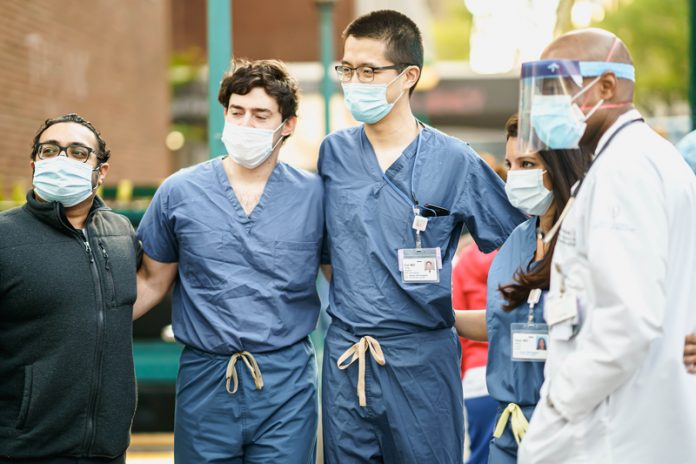European Trade Union Institute’s Marian Schaapman explains how COVID-19 reveals the state of health and safety in the workplace
The COVID-19 pandemic has provided a stress test for occupational safety and health (OSH) in the EU, unfortunately revealing several structural deficiencies in the way the EU OSH regulatory system is implemented in practice. This is the key message of the OSH chapter of ‘Benchmarking Working Europe 2020’ (1), one of the annual publications of the European Trade Union Institute (ETUI).
Examples of OSH issues in three sectors
Healthcare workers, nurses in particular, but also laboratory technicians, pharmacists, and cleaners, among others, are being exposed to hazardous medical products, including cytostatic drugs. These practices have existed already for decades, and preventive measures often don’t meet the necessary standards to properly protect the workers. For those highly exposed, this exposure leads e.g. to a 87% higher risk of breast cancer, a 64% higher chance of hematopoietic cancers and a 46% higher risk of miscarriages. (2) Moreover, healthcare workers have experienced increasing workloads over the years, due to rising staff shortages, caused by the cut in public spending since the financial crisis in 2008, which hit the healthcare sector particularly hard. They experience severe psychosocial risks from this accordingly. (3)
The working conditions in the European meat sector have been deplorable for decades, as the recent report of The European Federation of Food, Agriculture and Tourism Trade Unions (EFFAT) pointed out. (4) Workers work in cold temperatures, do highly repetitive work – even intensified by increasing line speeds to cope with the high competition in the sector – and the work requires a lot of physical strength. Moreover, they often make extremely long working hours. As a consequence, a growing number of workers suffer from occupational diseases, such as repetitive strain injuries (RSI) and other musculoskeletal disorders (MSD’s) and from psychosocial risk factors at work, the most common one being work-related stress. Moreover, occupational accidents, like cuts, slips and falls, are common. Not only are the OSH conditions bad for these workers, but also their employment status and housing conditions are extremely bad, all because most of them are vulnerable cross-border or migrant workers.
A recent ETUI report explores the psychosocial risks (PSR) encountered by gig workers (5), a large percentage of which perform their work (almost) completely on-line, that is: they telework full-time, bringing with it work characteristics, such as social and physical isolation, leading to PSR factors such as lack of social support, issues of work-life balance and unclarity about professional identity. All of these PSR can lead to many work-related mental complaints or disorders, such as stress, depression, exhaustion, burnout, family and marital conflicts, anxiety, alienation, boredom, lack of self-esteem, etc.
The COVID-19 pandemic as a magnifying mirror on OSH
These three completely different OSH situations have one thing in common: they have long been hidden from others than the ones involved and a small OSH professional community, but they have come into full daylight of society as a whole with the appearance of the COVID-19 pandemic. On top of all the risks described above, the two first sectors suffered from severe risk to catch COVID-19 and many outbreaks of the virus have been reported. All of a sudden, the health of healthcare workers was of general interest because society needed to continue the ‘essential service’ they delivered, and how would that be possible if numerous workers would fall ill (and even die).
The COVID-19 outbreaks among workers in the meat industry did not go without notice in society like all the other diseases and accidents these workers suffered from in the past. For this time, they caused a serious problem for the health of others. Work turned out to be a key vector in the spreading of the virus. Finally, as for the telework issue of platform workers: hardly anyone ever cared, but since COVID-19, a large percentage of office workers are forced to work from home for obvious reasons of limiting the contamination rate. Most of them telework (almost or completely) full-time, and after a year of experience, this does not go without OSH risks to be tackled. Besides the psychosocial risks that come with it, also, the ergonomic aspects of office-work from home need to be taken into account. The fact that the spotlight is on the issue, creates opportunities for improvements. The EU OSH legal system gives us enough basis and practical guidance to give shape to these improvements.
Opportunities in the EU OSH legal framework
Occupational Health and Safety is one of the fields of law, that has a strong European basis. The 1989 OSH ‘Framework Directive’ (89/391/EEC) lays down the principles that underpin community occupational health and safety legislation and 22 ‘daughter directives’ cover different risk factors and different categories of workers, providing more specific rules based on the Frameworks Directive’s principles.
This comprehensive body of legislation puts prevention at the heart of occupational health and safety regulation and has broad coverage: it requires all workers to be protected equally by health and safety law, regardless of their status.
Employers are legally responsible for healthy and safe workplaces, and workers have the right to be consulted on all matters related to OSH.
Practical instructions to give shape to this obligation are the obligation to regularly conduct a risk assessment and to take subsequent preventive measures. These measures should be integrated into all the activities of the undertaking and/or establishment and at all hierarchical levels.
The way forward: OSH as an organisational principle
If the OSH regulation would be properly implemented, the OSH situation in the sectors mentioned would not be as deplorable as described, and also COVID-19 as an OSH issue could be tackled. Why didn’t this happen a long time ago? One of the answers to this question is that OSH is often treated as a bold-on topic, whereas it should be placed at the heart of organisational design. OSH should be considered a basic principle that guides companies in the way they organise their work, both in terms of work processes as well as human and material resources. If that is done, also the COVID-19 measures will become part and parcel of work organisation and thus easily applicable and effective. How? That could be the topic of our next article.
References
(1) Countouris, N & R. Jagodzinsky (2020), Benchmarking working Europe 2020, Covid-19 and the world of work: the impact of a pandemic, Brussels, ETUC & ETUI.
(2) European Commission, DG Employment, Social Affairs and Inclusion, Background Report – Conference on workers’ protection from exposure to hazardous medical products, 24 and 25 September 2020.
(3) Franklin, Paula (2020)., Our failure to prevent known risks: Occupational safety and health in the health care sector during the Covid-19 pandemic. Policy Brief No 11/2020, Brussels, ETUI.
(4) EFFAT Report, Covid-19 outbreaks in slaughterhouses and meat processing plants. State of affairs and proposals for policy action at EU level, 1 September 2020.
(5) Bérastégui, Pierre (2021). Exposure to psychosocial risk factors in the gig economy: a systematic review. Report 2021-01. Brussels, ETUI.











